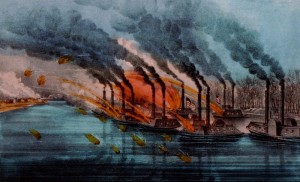Born near Claiborne, Maryland, on 18 January 1816, Lloyd Tilghman graduated from West Point in 1836. He decided not to become a professional soldier and resigned from the service. His only active military duty came during the Mexican War (1846-1848), when he served as a volunteer aid to General David E. Twiggs. Tilghman then worked as a construction engineer for various railroads. He entered Confederate service as a volunteer from Kentucky, which state he had adopted in 1852. In October 186 Tilghman secured a commission as a brigadier general and was originally appointed to inspect Fort Henry on the Tennessee River and Fort Donelson on the Cumberland. In December 1861 he assumed command of the two forts.
Tilghman and others who served at Fort Henry consistently criticized its location, and Tilghman later called it “a wretched military position.” Located on low ground close to the river, Fort Henry could easily be commanded by high ground on the opposite (west) bank. Yet Tilghman, while complaining was also dilatory in efforts to rectify the situation. By January 1862 he had barely started to fortify the heights on the west bank, named Fort Heiman after Fort Henry’s second in command. Having ordered the work done months before, theater commander General Albert Sidney Johnston was not pleased. although he telegraphed Tilghman to push efforts to entrench Heiman, work there remained unfinished when the Union expedition under General Ulysses S. Grant and commodore Andrew H. Foote arrived.
At Fort Henry, Tilghman had only 2,610 men in two brigades under Colonels Adolphus Heiman and Joseph Drake. Many of the defenders were raw recruits who had only shotguns or hunting rifles. Some even had flintlocks.
Tilghman was at Fort Donelson when late on 4 February he received word of the arrival above Henry of the Union flotilla. Tilghman immediately left Donelson to take up the direction of Fort Henry’s defense. He telegraphed General Leonidas Polk for reinforcements and on the next day optimistically stated “there was a glorious chance to overwhelm the enemy.” But no reinforcements arrived.
On the night of the fifth, realizing the strength of the opposing forces, Tilghman called together his principal officers. All were pessimistic, believing they could not withstand attack by an enemy they estimated to number at least 25,000 men. Tilghman then asked his artillery commander if his guns could hold out for an hour against a determined Union attack. When this officer replied in the affirmative, Tilghman ordered his commanders to have their men ready to move at a “moment’s notice.”
At ten o’clock on the morning of the sixth, just before the Union attack began, Tilghman ordered all but the artillery company manning the batteries to go to Fort Donelson. This left only about a hundred men at Henry including those too sick to move. Tilghman saw the rest of the men on their way to safety and then returned to the fort to share its fate. His intention was to delay the attackers long enough for most of his command to escape, and in this he was successful.
The Confederate gunners grew dispirited during the gunboat attack and Tilghman tried unsuccessfully to encourage them by working one of the guns himself. Finally, with only four guns able to return fire, at about 2 P.M., Tilghman surrendered to the Union flotilla commander Flag Officer Andrew H. Foote. Later, at Foote’s request, Tilghman went aboard the flagship.
Made a prisoner of war, Tilghman was exchanged in the fall of 1862 He then took command of the 1st Brigade in Major General William Wing Loring’s Army of the West and led that unit in the battle of Corinth, in the rear guard after Holly Springs, and in the Vicksburg campaign. He was struck by shell fragment and killed while directing artillery fire on 16 May 1863, during the battle of Champion’s Hill.
- Spencer C. tucker
[Source: Heidler, David S. and Jeanne T. Heidler. Encyclopedia of the American Civil War: A Political, Social and Military History. W.W. Norton & Co. 2002. p. 1954]
Click here to read the tribute to General Tilghman published in the July and September 1910 issues of Confederate Veteran.
His 1852 Greek Revival home at 631 Kentucky Avenue in Paducah, Kentucky is owned by Sons of Confederate Veterans and serves as a museum that highlights Western Kentucky’s role in the war. Information on visiting and touring the home can be found here.
The Paducah, Kentucky high school is named in his honor. A statue of General Tilghman was dedicated at Vickburg National Military Park on May 19, 1926.
For further reading:
Bush, Bryan S. Lloyd Tilghman: Confederate General in the Western Theatre Morley, MO: Acclaim Press, 2006.
Raab, James W. Confederate General Lloyd Tilghman: A Biography McFarland & Co. 2006.




Pingback: Bombardment of Fort Henry (Feb. 2-6, 1862) | This Week in the Civil War
The main high school in Paducah was not named for the General but for his wife, Augusta. When the two surviving children, Frederick & Sidell, came to Paducah in 1909 to dedicate a statue in memory of their father, they gave the City of Paducah a sum of money to buy a parcel of land & build a school in memory of their mother. It was named Augusta Tilghman High School & remained such until the mid-1950s when a newly built school was christened Paducah Tiilghman High School in order to reflect the city name. Even many current Paducahns often are under the misconception that the school was named for Lloyd rather than Augusta.
Thanks for the interesting information. It is a valuable contribution to this thread and I appreciate you taking the time to lend your expertise.